
应用化学 ›› 2025, Vol. 42 ›› Issue (1): 29-41.DOI: 10.19894/j.issn.1000-0518.240258
有机八极分子双光子激发荧光材料的设计合成与性能的研究进展
- 1.西南石油大学新能源与材料学院,成都 610500
2.汕头大学化学化工学院,汕头 515063
-
收稿日期:2024-08-11接受日期:2024-10-26出版日期:2025-01-01发布日期:2025-01-24 -
通讯作者:许良 -
基金资助:国家自然科学基金(52073167)
Research Progress in Design, Synthesis and Properties of Organic Octupolar Two-Photon Excited Fluorescence Materials
Liang XU1( ), Jian-Peng LIU2, Jian QING1
), Jian-Peng LIU2, Jian QING1
- 1.School of New Energy and Materials,Southwest Petroleum University,Chengdu 610500,China
2.College of Chemistry and Chemical Engineering,Shantou University,Shantou 515063,China
-
Received:2024-08-11Accepted:2024-10-26Published:2025-01-01Online:2025-01-24 -
Contact:Liang XU -
About author:liangxu@swpu.edu.cn
-
Supported by:the National Natural Science Foundation of China(52073167)
摘要:
双光子激发的荧光具有穿透深度大、空间分辨率高等优点,在生物成像领域具有重要的应用前景。 随着相关研究的不断创新、深入和拓展,有机偶极和四极分子材料因受自身结构和性能的限制,不能表现出令人期望的双光子激发荧光性能,并且在结构和性能上的可设计性和调控性较小,因此越来越无法满足实际应用的需求。 与有机偶极和四极分子材料相比,有机八极分子材料具有明显的优势,体现在可以通过对多个结构单元(中心核、分枝和π共轭桥)进行丰富多样的结构“裁剪”,借助分枝之间的相互耦合作用大幅提升双光子吸收截面,同时进一步优化分子的水溶性、细胞渗透性、生物相容性和激光稳定性等。 因此,近年来,越来越多的研究聚焦于有机八极分子双光子激发荧光材料。 通过重点综述近5年国内外有机八极分子双光子激发荧光材料的研究进展,讨论了新颖的中心核结构的设计合成、有机蓝光双光子激发荧光材料的双光子吸收响应的提高、双光子激发荧光材料的光稳定性和水溶性的提升以及双光子激发荧光材料的激发波长从近红外一区向近红外二区的扩展等内容。 并且对该领域研究进一步的发展趋势进行了讨论,为有机八极分子双光子激发荧光材料的进一步研发和应用提供依据。
中图分类号:
引用本文
许良, 刘健鹏, 青建. 有机八极分子双光子激发荧光材料的设计合成与性能的研究进展[J]. 应用化学, 2025, 42(1): 29-41.
Liang XU, Jian-Peng LIU, Jian QING. Research Progress in Design, Synthesis and Properties of Organic Octupolar Two-Photon Excited Fluorescence Materials[J]. Chinese Journal of Applied Chemistry, 2025, 42(1): 29-41.
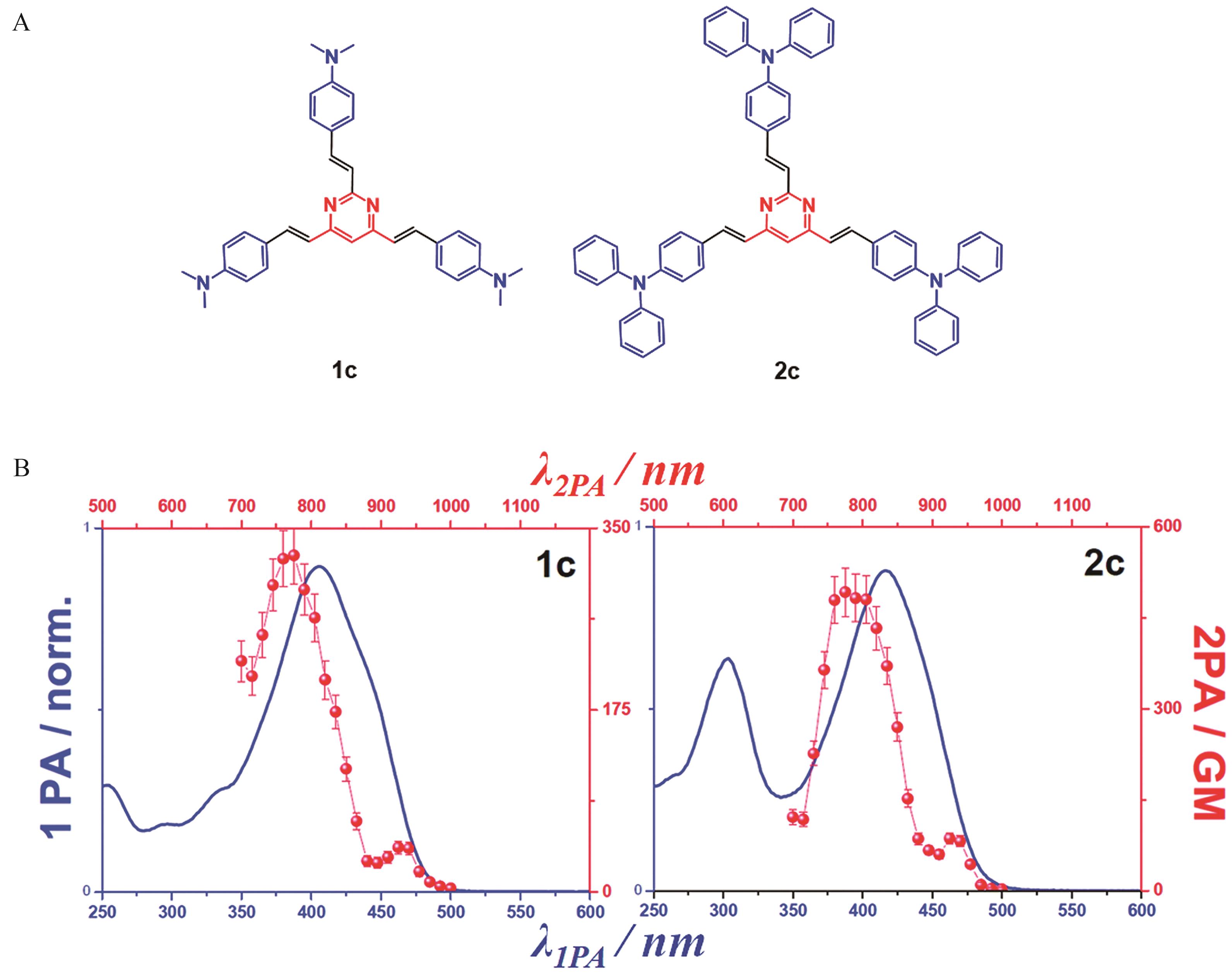
图1 (A)八极分子1c和2c的分子结构; (B)八极分子1c和2c在二氯甲烷中的单光子(线)和双光子吸收光谱(点),下横坐标代表单光子吸收波长,上面的横坐标代表双光子吸收波长,纵坐标代表双光子吸收截面[20]
Fig.1 (A) The molecular structure of octupolar molecules 1c and 2c; (B) One-photon (full line) and two-photon (dots) absorption spectra of octupolar molecules 1c and 2c in dichloromethane, where the lower abscissa represents the one-photon absorption wavelength, the upper abscissa represents the two-photon absorption wavelength, and the ordinate represents the two-photon absorption cross section[20]
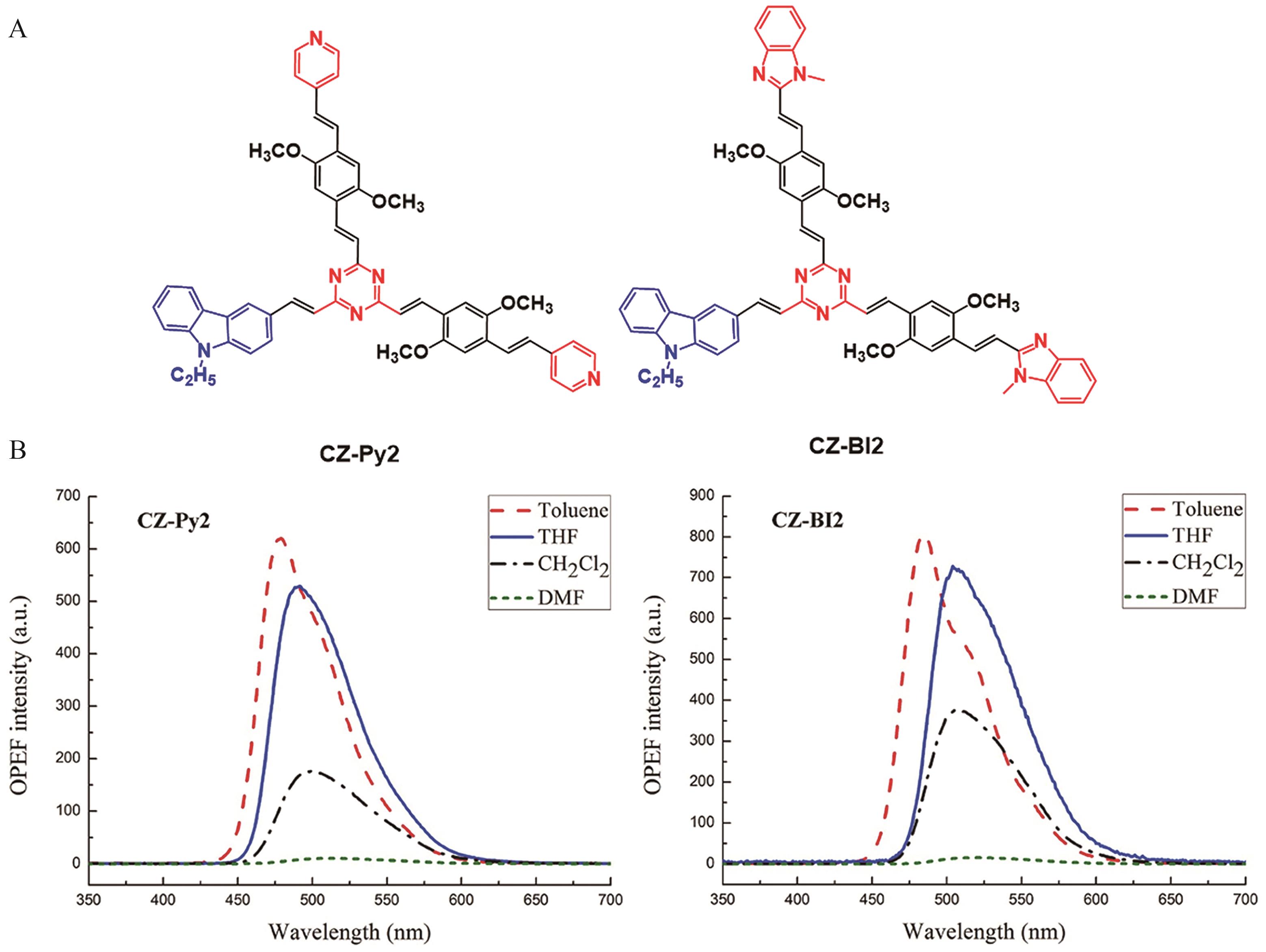
图2 (A)八极分子CZ-Py2和CZ-BI2的分子结构; (B)八极分子CZ-Py2和CZ-BI2在不同极性溶剂(甲苯、THF、二氯甲烷、DMF)中的单光子激发的荧光光谱[22]
Fig.2 (A) The molecular structure of octupolar molecules CZ-Py2 and CZ-BI2; (B) One-photon excited fluorescence spectra of octupolar molecules CZ-Py2 and CZ-BI2 in different polar solvents (toluene, tetrahydrofuran, dichloromethane, N,N'-dimethylformamide)[22]
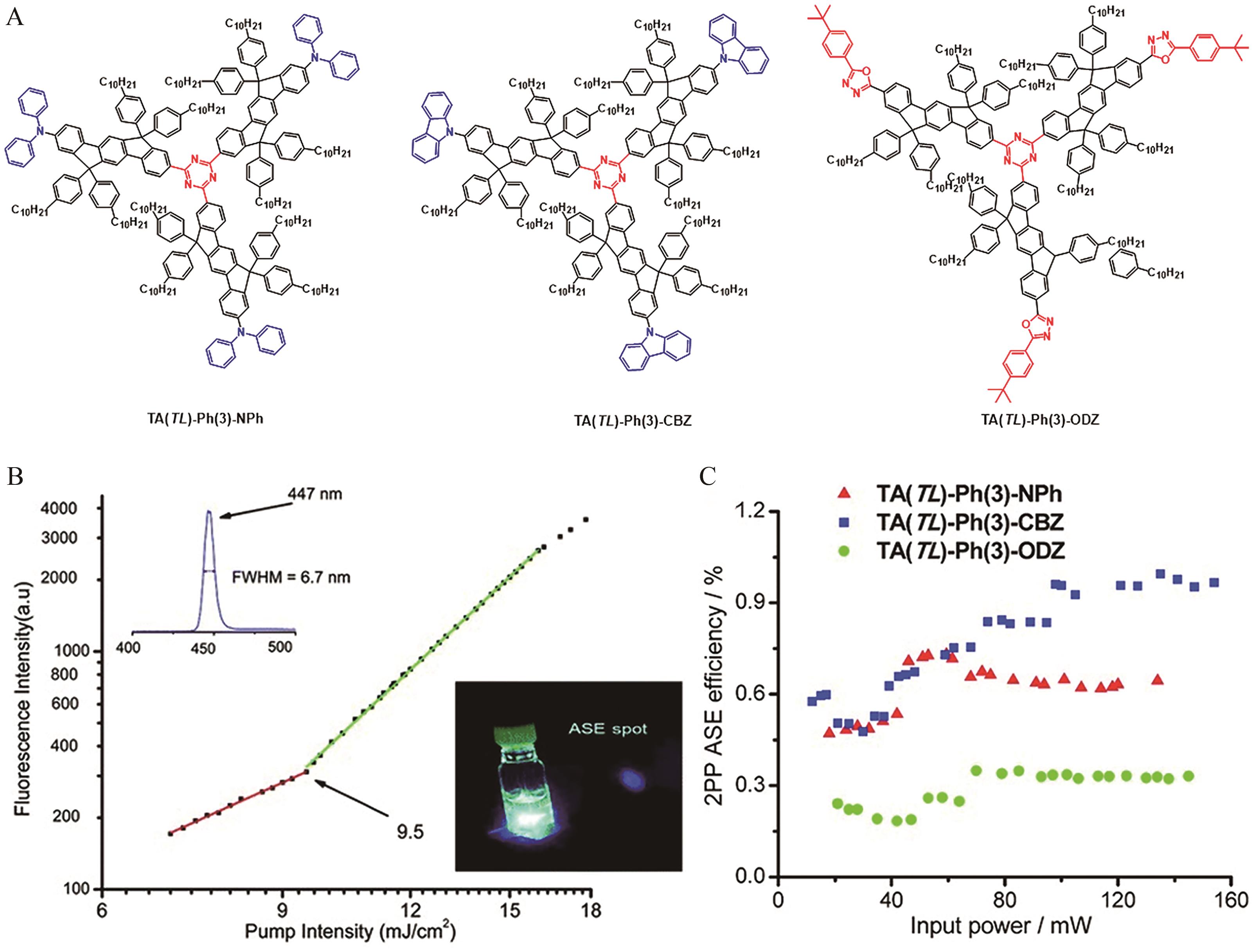
图3 八极分子TA(TL)-Ph(3)-NPh、TA(TL)-Ph(3)-CBZ和TA(TL)-Ph(3)-ODZ的分子结构; (B)在不同输入泵浦能量下,TA(TL)-Ph(3)-CBZ在甲苯中的双光子激发的荧光发射强度,插图:甲苯中TA(TL)-Ph(3)-CBZ的2PP ASE光谱; (C)在800 nm处,TA(TL)-Ph(3)-NPh、TA(TL)-Ph(3)-CBZ和TA(TL)-Ph(3)-ODZ的双光子放大的自发辐射效率与输入能量的关系[27]
Fig.3 (A) The molecular structure of octupolar molecules TA?(TL)?-Ph?(3)?-NPh, TA?(TL)?-Ph?(3)?-CBZ and TA(TL)-Ph(3)-ODZ; (B) Plots of integrated emission intensity vs. input pumping energy for TA(TL)-Ph(3)-CBZ in toluene. Inset: 2PP ASE spectrum of TA(TL)-Ph(3)-CBZ in toluene; (C) Plots of the 2PP ASE efficiency versus the input pumping intensity at 800 nm[27]
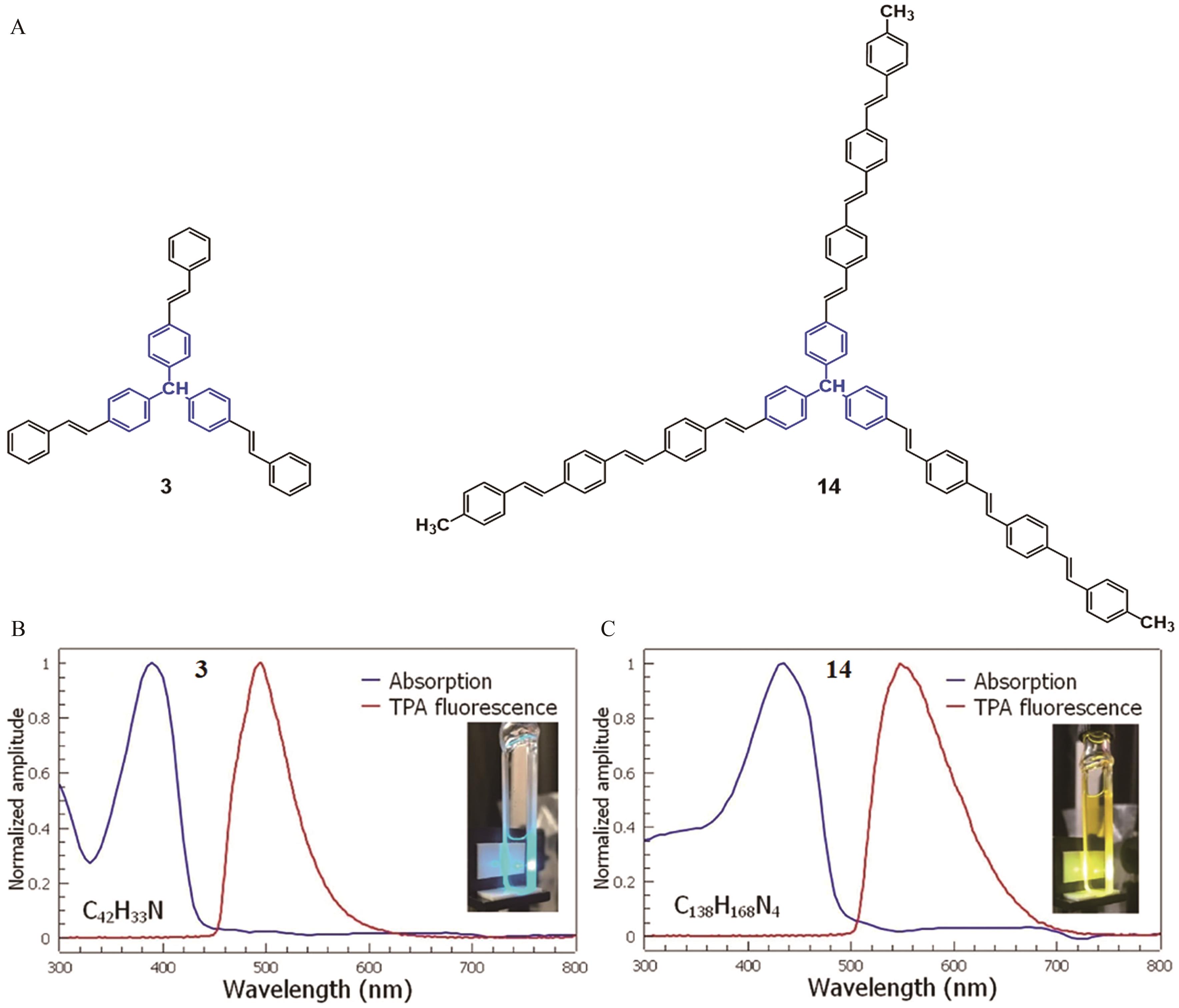
图4 (A)八极分子3和14的分子结构; (B)化合物3 (C42H33N)和(C)14 (C138H168N4)的紫外-可见吸收光谱(蓝线)和在800 nm飞秒激光激发下的双光子荧光发射光谱(红线)。 (B、C)的插图是2种相同浓度分子的双光子荧光照片[35]
Fig.4 (A) The molecular structure of octupolar molecules 3 and 14; (B) UV-Vis absorption and two-photon absorption (TPA) emission spectra of compounds 3 (C42H33N) (C) and 14 (C138H168N4) under the excitation of an 800 nm femtosecond laser. Insets of (B, C) are images of TPA fluorescent emission for two molecules with the same concentration[35]
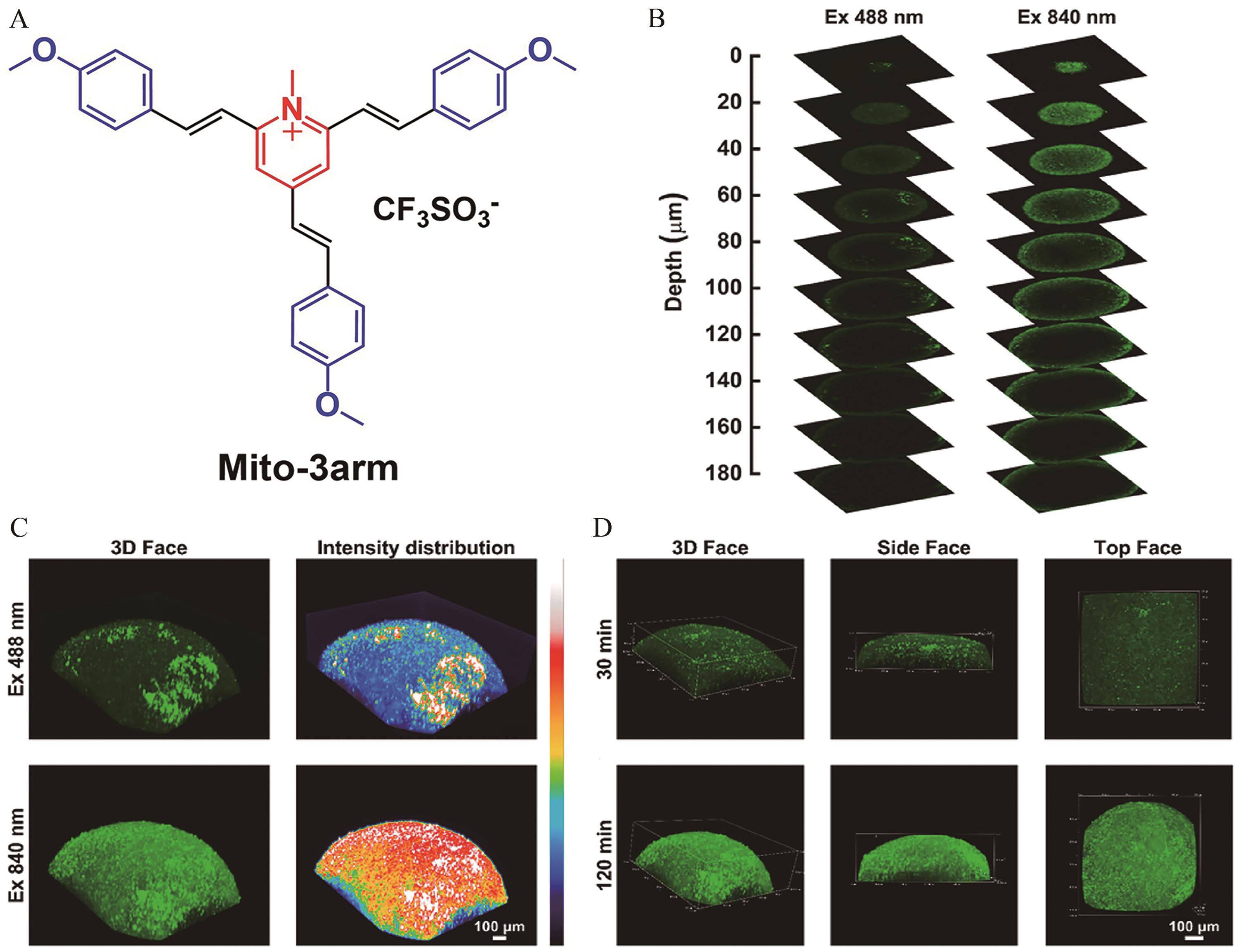
图5 (A)八极分子Mito-3arm的分子结构; (B)在单光子(488 nm)或双光子(840 nm)激发下,Mito-3arm在不同成像深度下的Z堆叠共聚焦显微镜图像; (C)在单光子(488 nm)或双光子(840 nm)激发下,由ImageJ构建的Mito-3arm的荧光强度分布图; (D)在30和120 min时获得Mito-3arm的双光子共聚焦显微镜图像[37]
Fig.5 (A) The molecular structure of octupolar molecule Mito-3arm; (B) Z-stack confocal microscopy images of organoids stained with Mito-3arm were recorded at different imaging depths using one-photon (488 nm) or two-photon (840 nm) excitation; (C) One-photon (488 nm) or two-photon (840 nm) excitation, along with corresponding fluorescence intensity distribution maps, constructed by ImageJ; (D) Two-photon confocal microscopy images of organoids stained with Mito-3arm were obtained at 30 and 120 min[37]
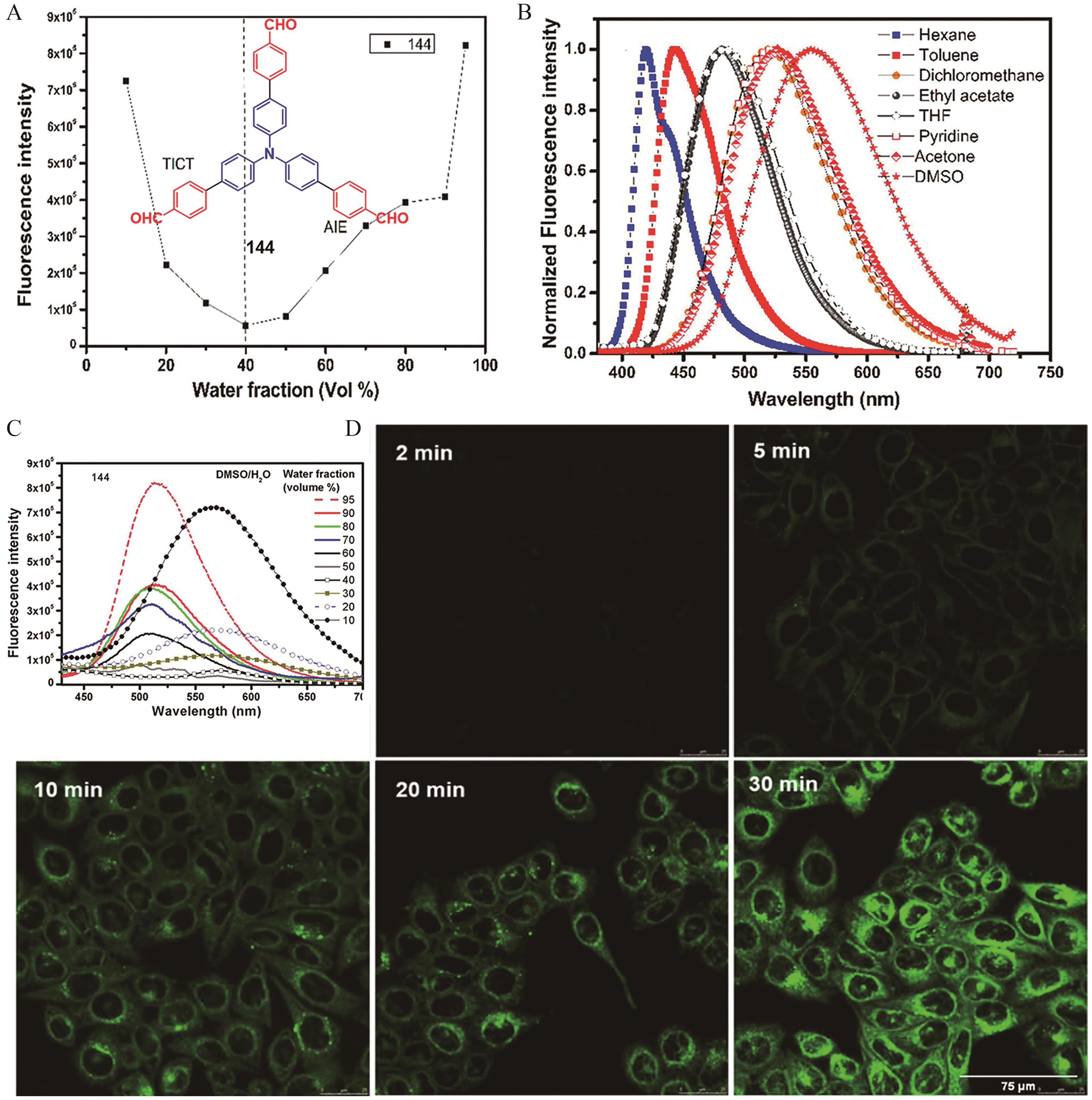
图6 (A) 144分子的荧光发射强度随H2O比例的变化分析, 插图: 八极分子144的分子结构; (B)分子144在不同溶剂中的荧光发射光谱; (C)分子144在不同配比的DMSO/H2O混合溶剂中的荧光发射光谱; (D)在820 nm激发并在不同孵育时间下,BSA/144染色的HeLa癌细胞的双光子荧光成像[42]
Fig.6 (A) Analysis of the change of fluorescence intensity of molecule 144 with the H2O fraction, inset: the molecular structure of octupolar molecule 144; (B) Fluorescence emission spectra of molecule 144 in different solvents with an excitation wavelength of 365 nm; (C) Fluorescence emission spectra of molecule 144 in DMSO/H2O with different ratios with an excitation wavelength of 365 nm; (D) Two-photon fluorescence imaging of HeLa cancer cells stained with BSA/144 excited at 820 nm with different incubation times[42]

图7 (A)八极分子F和F2的分子结构; (B) F和F2在四氢呋喃中的双光子吸收光谱; (C)基于荧光团的周期性介孔有机硅纳米颗粒的制备,包括荧光团F的硅基化过程以及溶胶-凝胶合成; (D)合成荧光团的双光子荧光成像照片[44]
Fig.7 (A) The molecular structure of octupolar molecule F and F2; (B) Two-photon absorption spectra of chromophores F and F2 in THF; (C) Preparation of fluorophore-based periodic mesoporous organosilica nanoparticles (F PMO NPs), including silylation process of fluorophore F and integration of resulting F—Si precursor in the sol-gel synthesis of E 4S F PMO NPs; (D) Two-photon fluorescence imaging of synthesized fluorophore-PMO NPs[44]
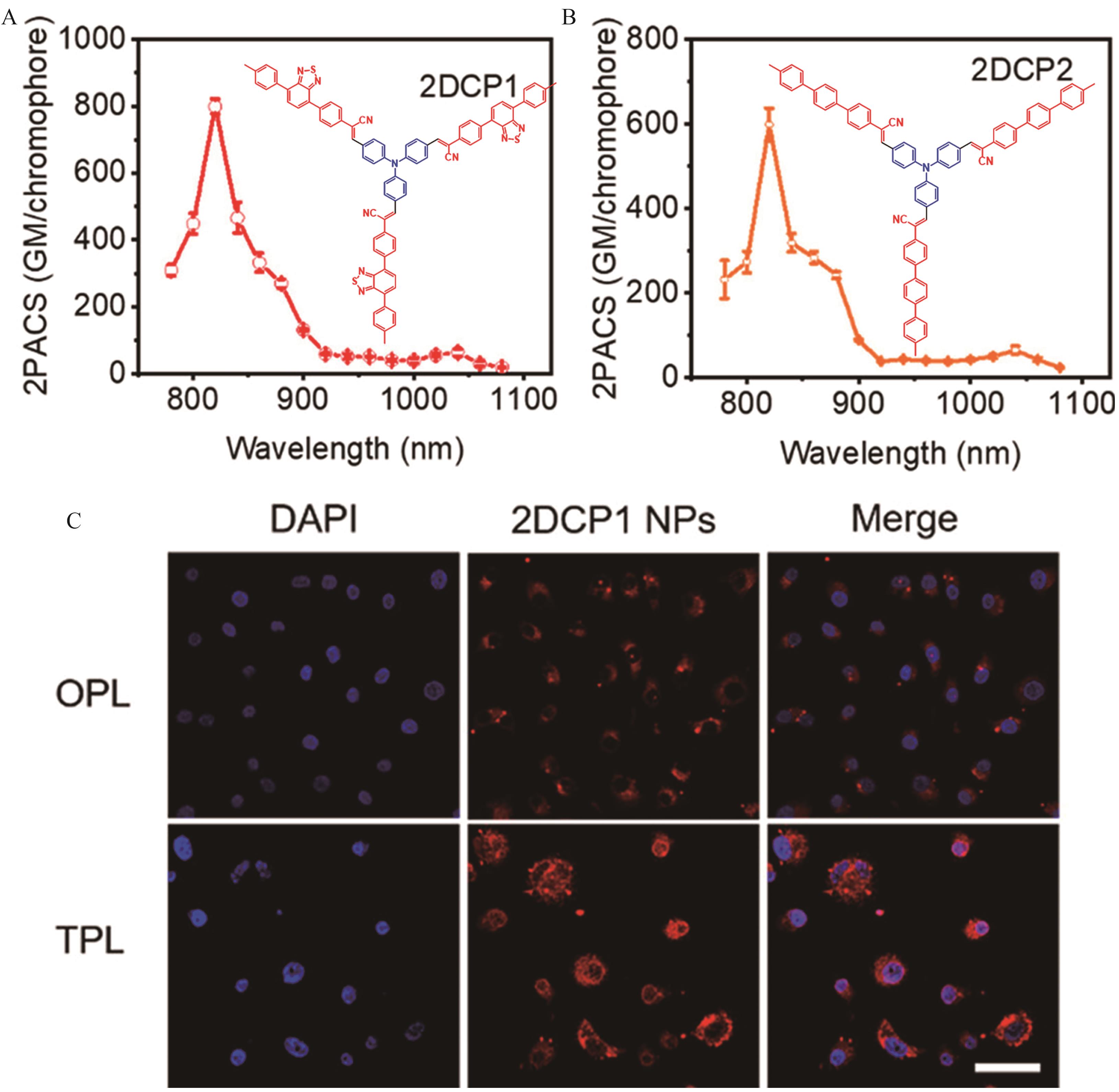
图8 (A) 2DCP1的八极分子结构以及在激发波长780~1080 nm下的双光子活性截面图 ;(B) 2DCP2的八极分子结构以及在激发波长780~1080 nm下的双光子活性截面图; (C)单光子(One-photon luminescence,OPL)和双光子(Two-photon luminescence,TPL)激发下的2DCP1 纳米颗粒在4T1细胞中的共聚焦激光扫描显微镜图像(比例尺: 50 μm)[46]
Fig.8 (A) The octupolar molecular structure of 2DCP1 and the two-photon action cross section of 2DCP1 under an excitation wavelength of 780~1080 nm; (B) The octupolar molecular structure of 2DCP2 and the two-photon action cross section of 2DCP2 under an excitation wavelength of 780~1080 nm; (C) Confocal laser scanning microscope images of 4T1 cells treated with 2DCP1 NPs excited by one- and two-photon excitation (scale bar: 50 μm)[46]
| 1 | WU L, LIU J, LI P, et al. Two-photon small-molecule fluorescence-based agents for sensing, imaging, and therapy within biological systems[J]. Chem Soc Rev,2021, 50(2): 702-734. |
| 2 | CHATTERJEE A, CHATTERJEE J, SAPPATI S, et al. Engineering TADF, mechanochromism, and second harmonic up-conversion properties in regioisomeric substitution space[J]. Chem Sci,2023, 14(47): 13832-13841. |
| 3 | HAO L, LIU F, WANG X, et al. Crystallography, charge transfer, and two-photon absorption relations in molecular cocrystals for two-photon excited fluorescence imaging[J]. Small,2024, 20(17): 2308470. |
| 4 | ZONG W, WU R, LI M, et al. Fast high-resolution miniature two-photon microscopy for brain imaging in freely behaving mice[J]. Nat Methods,2017, 14(7): 713-719. |
| 5 | ZONG W, WU R, CHEN S, et al. Miniature two-photon microscopy for enlarged field-of-view, multi-plane and long-term brain imaging[J]. Nat Methods,2021, 18(1): 46-49. |
| 6 | China's two-photon microscope captures cell images of astronauts in orbit[OL]. https://english.news.cn/20230227/4c20894032ed4528861ebcda13ba9ce4/c.html. |
| 7 | EVANS O R, LIN W. Crystal engineering of NLO materials based on metal-organic coordination networks[J]. Acc Chem Res, 2002, 35(7): 511-522. |
| 8 | BOIXEL J, GUERCHAIS V, LE BOZEC H, et al. Second-order NLO switches from molecules to polymer films based on photochromic cyclometalated platinum(Ⅱ) complexes[J]. J Am Chem Soc, 2014, 136(14): 5367-5375. |
| 9 | SUN C L, LI J, WANG X Z, et al. Rational design of organic probes for turn-on two-photon excited fluorescence imaging and photodynamic therapy[J]. Chem, 2019, 5(3): 600-616. |
| 10 | XU L, ZHANG J, YIN L, et al. Recent progress in efficient organic two-photon dyes for fluorescence imaging and photodynamic therapy[J]. J Mater Chem C, 2020, 8(19): 6342-6349. |
| 11 | PAWLICKI M, COLLINS H A, DENNING R G, et al. Two-photon absorption and the design of two-photon dyes[J]. Angew Chem Int Ed,2009, 48(18): 3244-3266. |
| 12 | CHO H J, KIM S W, KIM S, et al. Suppressing π-π stacking interactions for enhanced solid-state emission of flat aromatic molecules via edge functionalization with picket-fence-type groups[J]. J Mater Chem C, 2020, 8(48): 17289-17296. |
| 13 | XU L, LIN W, HUANG B, et al. The design strategies and applications for organic multi-branched two-photon absorption chromophores with novel cores and branches: a recent review[J]. J Mater Chem C, 2021, 9(5): 1520-1536. |
| 14 | FANG F, YUAN Y, WAN Y, et al. Near-infrared thermally activated delayed fluorescence nanoparticle: a metal-free photosensitizer for two-photon-activated photodynamic therapy at the cell and small animal levels[J]. Small, 2022, 18(6): 2106215. |
| 15 | NGUYEN V N, LEE D J, ZHANG D, et al. Rational design of efficient heavy-atom-free boron-dipyrromethene nanophotosensitizers for two-photon excited photodynamic therapy of cancer[J]. Chem Mater, 2024, 36(11): 5534-5541. |
| 16 | GRIESBECK S, MICHAIL E, RAUCH F, et al. The effect of branching on the one- and two-photon absorption, cell viability, and localization of cationic triarylborane chromophores with dipolar versus octupolar charge distributions for cellular imaging[J]. Chem Eur J, 2019, 25(57): 13164-13175. |
| 17 | NGUYEN T V, MAEDA T, MATSUYAMA T, et al. One-photon and two-photon absorption properties of multi-branched squaraine dyes comprised of triphenylamine cores and ethynylene linkers[J]. ChemPhotoChem, 2023, 7(11): e202300152. |
| 18 | ŠIMON P, KLIKAR M, BUREŠOVÁ Z, et al. Centripetal triazine chromophores: towards efficient two-photon absorbers and highly emissive polyimide films[J]. J Mater Chem C, 2023, 11(22): 7252-7261. |
| 19 | EL KAROUT H, ÖZKONSTANYAN A, SENTÜRK E, et al. Innovative triazine-core octupolar chromophores: unlocking new Frontiers in nonlinear optics[J]. J Mater Chem C, 2024, 12(30): 11458-11473. |
| 20 | KOURNOUTAS F, FIHEY A, MALVAL J P, et al. Branching effect on the linear and nonlinear optical properties of styrylpyrimidines[J]. PhysChemChemPhys,2020, 22(7): 4165-4176. |
| 21 | ZHANG L, ZOU L, XIAO J, et al. Symmetrical and unsymmetrical multibranched D-π-A molecules based on 1,3,5-triazine unit: synthesis and photophysical properties[J]. J Mater Chem,2012, 22(33): 16781-16790. |
| 22 | CAI Z B, CHEN L J, LI S L, et al. Synthesis, electronic structure, linear and nonlinear photophysical properties of novel asymmetric branched compounds[J]. Dyes Pigm,2020, 175: 108115. |
| 23 | GUO L, WONG M S. Multiphoton excited fluorescent materials for frequency upconversion emission and fluorescent probes[J]. Adv Mater, 2014, 26(31): 5400-5428. |
| 24 | HE G S, TAN L S, ZHENG Q, et al. Multiphoton absorbing materials: molecular designs, characterizations, and applications[J]. Chem Rev, 2008, 108(4): 1245-1330. |
| 25 | XU W, YI J, LAI W Y, et al. Pyrene-capped conjugated amorphous starbursts: synthesis, characterization, and stable lasing properties in ambient atmosphere[J]. Adv Funct Mater, 2015, 25(29): 4617-4625. |
| 26 | GUO L, LI K F, WONG M S, et al. Star-shaped ladder-type ter(p-phenylene)s for efficient multiphoton absorption[J]. Chem Commun, 2013, 49(34): 3597-3599. |
| 27 | GUO L, LIU X, ZHANG T, et al. Star-shaped triazine-cored ladder-type ter(p-phenylene)s for high-performance multiphoton absorption and amplified spontaneous blue emission[J]. J Mater Chem C,2020, 8(5): 1768-1772. |
| 28 | FLETCHER A N. Laser dye stability[J]. Appl Phys B, 1983, 31(1): 19-26. |
| 29 | COSTELA A, GARCÍA-MORENO I, GOMEZ C, et al. Photophysical and lasing properties of new analogs of the boron-dipyrromethene laser dye PM567 in liquid solution[J]. J Phys Chem A, 2002, 106(34): 7736-7742. |
| 30 | CALZADO E M, VILLALVILLA J M, BOJ P G, et al. Effect of structural modifications in the spectral and laser properties of perylenediimide derivatives[J]. J Phys Chem C, 2007, 111(36): 13595-13605. |
| 31 | MIASOJEDOVAS A, KAZLAUSKAS K, ARMONAITE G, et al. Concentration effects on emission of bay-substituted perylene diimide derivatives in a polymer matrix[J]. Dyes Pigm, 2012, 92(3): 1285-1291. |
| 32 | GARCÍA-MORENO I, COSTELA A, CAMPO L, et al. 8-Phenyl-substituted dipyrromethene·BF2 complexes as highly efficient and photostable laser dyes[J]. J Phys Chem A, 2004, 108(16): 3315-3323. |
| 33 | OYAMA Y, MAMADA M, SHUKLA A, et al. Design strategy for robust organic semiconductor laser dyes[J]. ACS Mater Lett, 2020, 2(2): 161-167. |
| 34 | SZUKALSKA A, ZAJAC D, CYPRYCH K, et al. Ultra-photostable random lasing coming from the benzothiadiazole derivative dye-doped organic system[J]. J Phys Chem C, 2023, 127(51): 24618-24625. |
| 35 | GONG Y, HOU G L, BI X, et al. Enhanced two-photon absorption in two triphenylamine-based all-organic compounds[J]. J Phys Chem A,2021, 125(9): 1870-1879. |
| 36 | ZHANG J, AN Q, LI W, et al. Rationally designed lipid droplets-selective two-photon nitric oxide probe for high-fidelity neuroinflammation evaluation[J]. Sens Actuators B:Chem, 2021, 345: 130329. |
| 37 | CHEN R, QIU K, LEONG D C Y, et al. A general design of pyridinium-based fluorescent probes for enhancing two-photon microscopy[J]. Biosens Bioelectron,2023, 239: 115604. |
| 38 | NIU G, ZHENG X, ZHAO Z, et al. Functionalized acrylonitriles with aggregation-induced emission: structure tuning by simple reaction-condition variation, efficient red emission, and two-photon bioimaging[J]. J Am Chem Soc, 2019, 141(38): 15111-15120. |
| 39 | NIU G, ZHANG R, GU Y, et al. Highly photostable two-photon NIR AIEgens with tunable organelle specificity and deep tissue penetration[J]. Biomaterials, 2019, 208: 72-82. |
| 40 | SHI L, NGUYEN C, DAURAT M, et al. Biocompatible conjugated fluorenylporphyrins for two-photon photodynamic therapy and fluorescence imaging[J]. Chem Commun, 2019, 55(81): 12231-12234. |
| 41 | GAO S, WEI G, ZHANG S, et al. Albumin tailoring fluorescence and photothermal conversion effect of near-infrared-Ⅱ fluorophore with aggregation-induced emission characteristics[J]. Nat Commun, 2019, 10(1): 2206. |
| 42 | LIU T, XU L, WANG H, et al. Organic nanoparticles with aggregation-induced emission and two-photon excitation for fluorescence imaging of living cells/tissues[J]. ACS Appl Bio Mater, 2023, 6(7): 2849-2859. |
| 43 | RODRIGUES M O, ISOPPO V G, MORO A V, et al. Photoactive organic-inorganic hybrid materials: from silylated compounds to optical applications[J]. J Photochem Photobiol C, 2022, 51: 100474. |
| 44 | BONDON N, RICHY N, ALI L M A, et al. Synthesis, photophysical characterization, and integration of two-photon-responsive fluorophores in mesoporous organosilica nanoparticles for biological imaging use[J]. Tetrahedron,2023, 144: 133577. |
| 45 | HONG G, ANTARIS A L, DAI H. Near-infrared fluorophores for biomedical imaging[J]. Nat Biomed Eng, 2017, 1(1): 0010. |
| 46 | HE Z, XU Z, YAN Z, et al. NIR-Ⅱexcitable water-dispersible two-dimensional conjugated polymer nanoplates for in vivo two-photon luminescence bioimaging[J]. ACS Appl Mater Interfaces,2024, 16(1): 142-152. |
| [1] | 尹娜, 王樱蕙, 张洪杰. 稀土纳米材料在脑肿瘤成像和治疗中的研究进展[J]. 应用化学, 2024, 41(3): 309-327. |
| [2] | 赵欣雨, 秦作佳, 张晓兵, 袁林. 近红外二区激活型小分子荧光探针研究进展[J]. 应用化学, 2024, 41(1): 39-59. |
| [3] | 杜慧, 姚晨阳, 彭皓, 姜波, 李顺祥, 姚俊烈, 郑方, 杨方, 吴爱国. 过渡金属掺杂磁性纳米粒子在生物医学领域中的研究进展[J]. 应用化学, 2022, 39(3): 391-406. |
| [4] | 王涛,马拉毛草,马恒昌. 基于聚集诱导发光荧光探针的细胞成像研究进展[J]. 应用化学, 2018, 35(10): 1155-1165. |
| [5] | 黄子珂, 刘超, 付强强, 李进, 邹建梅, 谢斯滔, 邱丽萍. 核酸适配体荧光探针在生化分析和生物成像中的研究进展[J]. 应用化学, 2018, 35(1): 28-39. |
| [6] | 周佳, 倪赟, 张承武, 仇兴汉, 赵燕菲, 白磊, 张高宾, 李林. 嘧啶基双光子荧光染料的设计合成与生物成像[J]. 应用化学, 2017, 34(12): 1450-1456. |
| [7] | 周佳, 倪赟, 张承武, 仇兴汉, 赵燕菲, 白磊, 张高宾, 李林. 嘧啶基双光子荧光染料的设计合成与生物成像[J]. 应用化学, 2017, 34(12): 0-0. |
| [8] | 李海东,姚起超,樊江莉,杜健军,彭孝军. 钯离子荧光探针的研究进展[J]. 应用化学, 2016, 33(10): 1099-1114. |
| [9] | 李萍, 钟顺和. 光催化材料Cu/Fe2O3-TiO2的结构和性能[J]. 应用化学, 2006, 23(6): 586-590. |
| [10] | 高瑛, 殷敬华. 线性低密度聚乙烯和聚苯乙烯共混物的原位增容及其形态、结构和性能[J]. 应用化学, 2002, 19(9): 822-826. |
| 阅读次数 | ||||||
|
全文 |
|
|||||
|
摘要 |
|
|||||